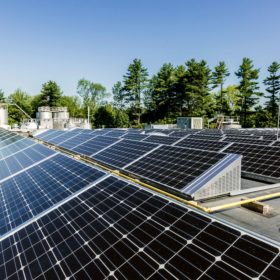
How can you get the gigawatts of distributed solar generation in the WA South West Interconnected System to play nicely with the network? Western Power has gathered 100 MW of resource to test its coordinated ability to stabilize the system on low-demand days.
From pv magazine Australia.
Western Power this weekend released further details of its 100 MW Challenge, aka the ‘Flexibility Services Pilot’, and provided a microsite that informs existing and potential partners (aggregators) and participants (businesses that sign up to shift significant loads and generation) with details of working together to better manage the state’s vast renewable energy resources towards greater grid stability.
Businesses involved in the pilot will be asked to change their energy use and generation between 10 a.m. and 2 p.m. — times of peak solar generation but low demand in mild weather — on 26 weekend days in spring 2020 and autumn 2021, in return for financial incentives.
These commercial and industrial businesses will be coordinated by aggregators to manage their distributed energy resources, such as solar PV and batteries; and manageable loads, such as heating and cooling systems, to help support the network.
This era of transition is “maybe the most exciting time to be in innovation in energy,” said Tracy Deveugle-Frink, Western Power’s head of change and innovation, in a video released yesterday to accompany kick-off of the pilot. She said: “Everything is up for grabs now, everything is changing. It’s a once-in-a-lifetime opportunity to rethink what we’ve always done.” That is, the era of generating power from central fossil-fueled plants and distributing energy to consumers on a one-way energy system, is no longer viable.
Sunlight, VPP, uninterrupted action
Today, with one in three WA households having installed solar on the roof, and that penetration of distributed resource still on a growth trajectory that includes the commercial and industrial sectors, Western Power needs to balance the flow of energy generated by rooftop resources at times when demand is low, to keep the network running at optimal levels. Otherwise, when solar generation outruns the demand for energy, it creates what’s known as a ‘system low’ such that the power being drawn from large scale generators drops below their minimum operating limits, which has already caused outages.
This instability was forecast by AEMO to increase to crisis levels by 2022 if unmanaged, and the Western Australian government has declared its determination to continue to offer consumers the ability to benefit from installing solar as they come to that decision, rather than curtailing PV uptake — one alternative management strategy.
What’s with the 100 MW Challenge?
The Flexibility Services Pilot aims to be able to control a collective 100 MW of solar coming into the grid in mild, sunny weather — during times of decreased use of heating, air conditioning, pool pumps and other loads that in summer and winter help to soak up peak solar generation.
To counteract this seasonal change in demand, commercial and industrial pilot participants will be coordinated by Western Power partners to “shift” their energy use in a way that is productive for each of them.
Western Power is quick to point out that the intention is not to waste energy at peak generation times, nor to disrupt the processes of participants in a way that might disadvantage them; their responses could instead include switching off their own solar when demand is low or shifting energy-intensive activity to use more power at times of high solar generation.
Such measures, says Deveugle-Frink, have proven successful in similar trials conducted in the United Kingdom and the United States, helping to support network stability and thereby enabling further uptake of renewables.
An orderly unfolding of the DER Roadmap
The trial forms an important part of the state’s Distributed Energy Resources Roadmap, published in April, which Deveugle-Frink describes as “an amazing advantage here in the West … It really lays out a whole-of-system approach for how we prepare for the decarbonization transformation … in a way that gives everyone a role to play.”
This year has already seen Western Power invest in grid-support technologies, including 5 MVAr reactor units that provide reactive power compensation when energy demand in Western Australia’s Wholesale Electricity Market (WEM) is lower than the system can safely withstand.
Another milestone on the roadmap, the roll-out of 500 kW community batteries to 13 WA communities — aka the PowerBank Trial — is currently demonstrating how shared energy storage, which residents can use for a minimal subscription rather than investing in their own home batteries, can store peak generation on behalf of households and provide access for them to use that energy when the sun goes down.
Learning while doing
The Flexibility Services Pilot microsite says that the results of the pilot, analysed over a one-year period “will inform our future activities, which may require a change to the mechanism or even a different approach.”
It’s hoped that this virtual-power-plant mechanism of aggregating loads and generation will demonstrate the technical ability of distributed energy resources to respond in a coordinated way under central-dispatch instructions.
Within two years, the pilot is also expected to demonstrate “the incorporation of aggregated DER into energy markets, including market dispatch and settlement arrangements” from the market operator to individual participants, states the roadmap.
Deveugle-Frink says that the The Flexibility Service Trial plays an important part in rethinking and re-imagining the WA electricity system: “It’s our opportunity to learn while doing, learning how this works on the ground with customers, participants and partners, in a way that ensures we’re all getting real value and all driving towards a greater goal, which is really decarbonizing our environment and our economy for the benefit of our community.”
Lắp đặt điện mặt trời Khải Minh Tech
https://ift.tt/2X7bF6x
0906633505
info.khaiminhtech@gmail.com
80/39 Trần Quang Diệu, Phường 14, Quận 3
Lắp đặt điện mặt trời Khải Minh Tech
https://ift.tt/2ZH4TRU
Không có nhận xét nào:
Đăng nhận xét